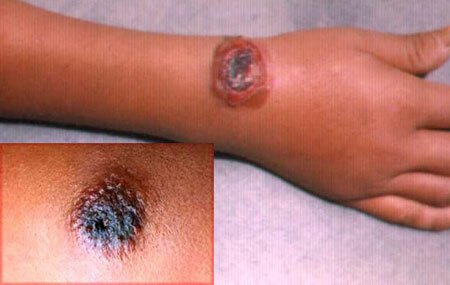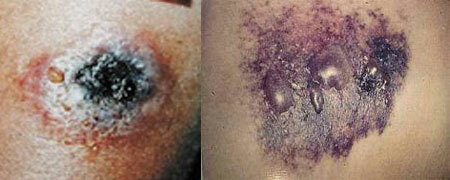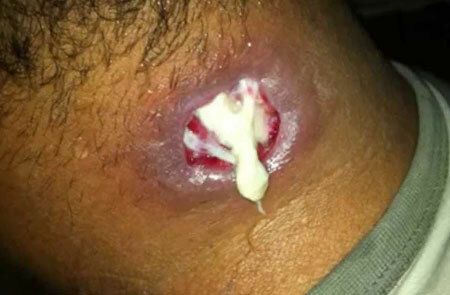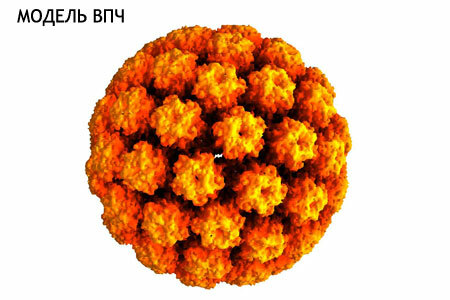The list of WHO registered more than a hundred diseases of infectious nature, belonging to the class of extremely dangerous. Anthrax, anthrax anthrax or anthrax is the brightest representative of this classification, which has the capacity for sudden manifestation, rapid spread and massive infection, be it animals or humans. Characterized by severe course and increased mortality.
Shortly anthrax infection in humans was described in ancient treatises by scientists of ancient times, comparing its rapid manifestation with sacred fire charring the body of a person( carbon color of carbuncles), see the photo.
Contents
- 1 Anthrax - pathogen and pathways of infection
- 2 Anthrax - human symptoms, photo
- 3 Anthrax treatment, preparations
- 4 Anthrax prevention methods
Anthrax is an agent and pathways of infection

anthrax in humans Photo
In humans, anthrax is caused by anthraxpathogenic( pathogenic) microorganisms of the family Bacillus anthracis. Bacteria have a Gram-positive characteristic( cells are stained by the Gram method), easily form endospores in the external environment and are distinguished by high survival and resistance to any effects.
Source of infection for people - infected or dead from anthrax animals.
For the infection, the seasonality of the manifestation is typical - summer, autumn - this is due to the increase in animal diseases in this period. The disease is more susceptible to men caring for sick cattle, taking part in their face and further cutting.
The incubation period of anthrax in humans is very short, the disease can manifest itself for several hours and after 8 days - usually on the 2nd or 3rd day after infection. For effective treatment of anthrax it is important to start it as early as possible - the disease develops rapidly and even today the prognosis of life is not always favorable.
Anthrax infection is transmitted by:
- by direct contact with a sick animal, or by contact with agricultural raw materials or soil, contaminated with spores of the pathogen;
- possible alimentary infection( with food or through dirty hands);
- transmissive( by blood - transfer through scratching or biting);
- air-aerosol - ingress of bacterial spores when inhaled on the mucous coating of organs.
Process of development of
The bacterial spores themselves are not dangerous for humans or animals, until they are introduced into a suitable environment for development. With skin bacterial implantation, an inflammatory reaction develops in the site of penetration.
It forms a hemorrhagic focus with signs of tissue necrosis, edema in the surrounding tissue and development of bubo( carbuncle), as a consequence of the development of regional lymphadenopathy.
This local process develops under the action of bacterial exotoxin - a strong poison that causes in the body pronounced functional disorders in the circulation system that provokes the formation of tissue swelling and coagulation dry necrosis.
For reasons independent of the site of localization, the symptoms of anthrax of the first stage of the disease are manifested by local damage to regional( local) lymph nodes and symptoms of generalization of the process - in the second stage of development.
Anthrax - symptoms in humans, photo

carbuncle in anthrax photo
 In the course of a long-term study and observation of infected patients, various forms of clinical manifestations of anthrax in man - cutaneous form, intestinal and pulmonary localization, forms of septic development - were revealed. Manifestation in humans of anthrax symptoms is due to the species classification of the disease.
In the course of a long-term study and observation of infected patients, various forms of clinical manifestations of anthrax in man - cutaneous form, intestinal and pulmonary localization, forms of septic development - were revealed. Manifestation in humans of anthrax symptoms is due to the species classification of the disease.
- Manifestation of cutaneous infection
With the dermal form of anthrax, a breakthrough in the bloodstream and sepsis, due to generalization of the infection, is extremely rare. Its classification includes several varieties, manifesting carbuncleous, edematous, bullous and erysipeloid form of the disease.
1) Carbunculous anthrax infection is the most common form of the disease, occurring in more than 95% of cases among infected patients. It is manifested by local skin changes in the entry area of the infection. The first changes appear in the form of a red patch that rises above the skin. Subsequently, after passing all the stages of development( nodule, bladder, abscess), the spot turns into ulcerative formation.
The process of transforming the initial spot into a purulent pustule is very fast, accompanied by itching and burning, takes only a few hours. Purulent pustular contents are mixed with impurities of blood and acquire a charcoal color. Combinations or awkward movements can destroy the integrity of the abscess, the contents flow out, forming ulceration, which is subsequently covered with a black scab.
The dead ulcerous edges, like a necklace, encircle the newly formed abscesses. Their destruction promotes the expansion of the main ulcerative focus. The skin adjacent to it is hyperemic and swollen, which is especially noticeable when the abscess develops on the skin of the face. The sensitivity in the area of ulcerative formation decreases or is completely lost.
The second day of the disease begins with an intoxication symptomatic, manifested:
- feverish condition with very high temperature indexes;
- sensation of impotence;
- a sense of depression and a strong migraine;
- with adynamic features;
- tachycardia.
After a week of high fever, it abruptly declines, the ulcerative formation heals and after a couple of weeks the scab falls off. As a rule, carbuncles develop singly, but there are cases of multiple formations - up to three dozen. At the same time, there were no significant differences in the course of the disease from single localizations.
Sibiriazvennaya infection in those patients who had not been vaccinated before, proceeds with minor pathologies of the skin resembling furunculosis, intoxication symptoms may not be manifested at all.
2) The edematous form of is rarely noted. The disease proceeds severely with a strong intoxication syndrome, but without apparent ulcerative manifestations. First, there is swelling. The skin becomes dense and even later, it is covered with a scab.
3) Bullous manifestation of differs by bubble rashes instead of ulcerative formations in the area of infection. The cavity of the blisters is filled with purulent exudate. The formations can be very large, after a week and a half, they are opened, forming a large ulcer surface.
4) Erisipeloid cutaneous anthrax infection belongs to rare forms. It is characterized by a large number of bubble manifestations, filled with whitish exudate. They are located on hyperemic, edematic skin. After the autopsy, there are a lot of drying sores.
- Pulmonary form
Type of pulmonary pathology refers to very severe forms of the disease, manifested by acute course. Even the most effective drugs and modern anthrax treatment, sometimes can not prevent lethality. Against the backdrop of excellent health, there is a strong chill, temperature indicators are rapidly increasing to critical levels. There are:
- signs of acute conjunctivitis;
- catarrhal symptoms;
- strong stitching soreness in the chest;
- heart palpitations and shortness of breath;
- signs of cutaneous cyanosis and hypotension;
- bloody impurities in the phlegm.
When listening to the lungs, there are - blunted percussive sound over the lungs, wet and dry sounds, sometimes the sounds of clear pleural friction. The lethality comes on the third day.
Intestinal anthrax is manifested:
- acute intoxication symptoms;
- hyperpyretic fever and pain syndrome in epigastrium;
- with diarrhea and vomiting with blood inclusions;
- bloating and abdominal pain;
- by irritation of the peritoneum.
Rapid deterioration of the state provokes a breakthrough of bacteria in the blood. Isolation of endotoxins leads to infectious-toxic shock and death of the patient.
The Siberian septic species can practically develop with any of the above described diseases, which is caused by the introduction of an infectious microorganism through the mucous coat of the respiratory and gastrointestinal systems.
In such cases, generalization of the process is a consequence of violations of protective barrier functions in the tracheobronchial lymph nodes and lymph nodes of the intestinal department - mesenteric. Often, with the development of secondary foci in internal organs.
Anthrax treatment, preparations

The basis for diagnosis of anthrax infection is the collection of data and the identification of possible routes of infection( anamnesis of the environment).For diagnostic confirmation, laboratory research methods are used, including:
Identification of an anthrax bacteria and its identification by fence methods and examination of material from pustules, blisters and subcortical effusions in the carbuncle.
If a pulmonary infection is detected, the blood, feces and sputum are examined.
To identify the pathogen is also used immunofluorescence study and, as an auxiliary method, apply the allergic test - intradermal injection of the allergen "Antraxin".
If the infiltrative hyperemia, which is more than 1 cm in size appears after the test, does not disappear in diameter for two days, the reaction is considered positive.
Therapeutic therapy
Antibiotics and immunoglobulin preparations are used as etiotropic therapy for the treatment of anthrax.
- In the local process, pulmonary form and septic manifestations, "Ciprofloxacin" or "Doxycycline" is prescribed. Intravenous or intravenous administration - in an age dose twice / day.
- Penicillin preparations have proved effective in the treatment of anthrax in humans. Parenteral one-time administration per day "Ampicillin" or "Oxacillin" is prescribed for a cutaneous variant of the disease. When swelling comes in the zone of the pathological process, the drugs can be used orally for another one and a half weeks.
- With the addition of meningitis, the administration of penicillin preparations is combined with the necessary age-related doses of "Hydrocardisone".
- In the intestinal and pulmonary form of the disease, the use of antibiotics is useless if they were not administered immediately after infection. The effectiveness of the treatment of anthrax depends on its timeliness, started at the early stages of the development of the disease - the rapid development of the process does not leave the patient a chance to survive.
- Intoxication symptoms of anthrax and treatment of complicated processes are carried out according to the established general method of intensive therapy.
Methods for the prevention of anthrax
Prevention of the disease includes medical and veterinary sanitary measures that perform tasks to identify the epidemic outbreaks and their sanitation. Control of water resources of the region, pastures and livestock farms is being carried out.
Vaccinations are carried out on farms, raw materials handling, transportation of products and storage conditions are monitored. The correct utilization of dead animals is monitored.
Individual measures in the form of vaccine prophylaxis are necessary for persons at risk, due to professional activities. Disinfection is carried out in the areas of probable infection.
When contacting a suspicious object, but not later than five days after it, an emergency preventive antibiotic therapy is carried out.



